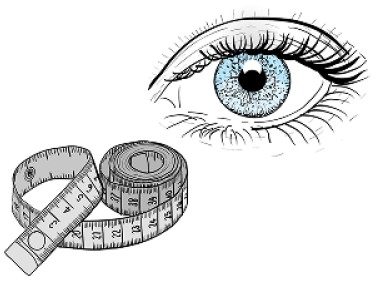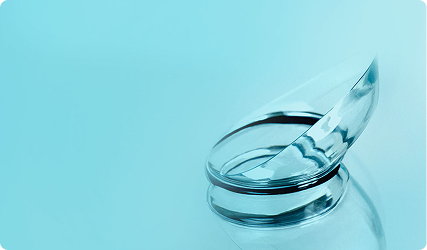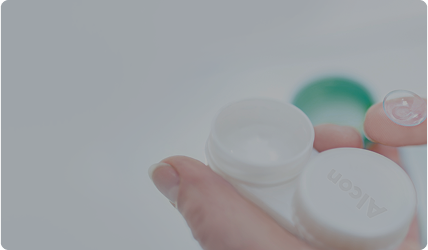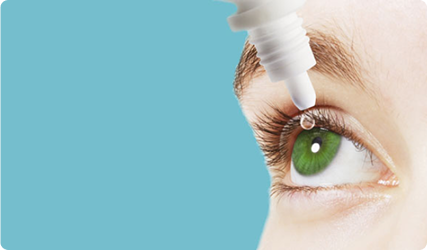Contact Lenses and Care
Are Gas Permeable (Rigid) Contact Lenses a Good Idea?1
7 mins read
It’s a good question. In a world of soft contact lenses, why would you select a hard(er) one? Read on to find the answer…
When modern contact lenses first became a viable idea, they were made from PMMA, a hard plastic also known as acrylic glass. These contact lenses corrected vision, sat just on the cornea, but let no oxygen through. Only their movement during blinking pumped oxygen under the lens.
In the 1970s these contact lenses evolved into rigid (gas permeable) lenses. It’s fair to say the name doesn’t do justice to a whole new way of seeing! However, these lenses did let oxygen pass through to the eye, making them much more comfortable and safe to wear, for longer.
Even so, the lens material was stiff, often uncomfortable in the first days and weeks of using them (until one got used to new sensation) and a world away from today’s sophisticated world of immediate comfort.
Since then, most people have benefited from a new age of soft hydrogel and silicone hydrogel contact lenses, worn during the day and then either disposed daily of or (in the case of monthly replacement lenses) cleaned, disinfected and stored overnight then replaced after 30 days.
With such soft and gentle contact lenses to choose from, why would anyone want to stick with gas permeables?
The answer is that this technology has moved on too.
Modern gas permeable contact lenses are made from fluorosilicone acrylates and also incorporate silicone, to increase oxygen transmitted to the cornea. And despite the ‘rigid’ terminology, nowadays these contact lenses are quite flexible as well. That makes rigid gas permeables (often known as RGPs or simply GPs) a real and valid alternative to soft contact lenses for contemporary contact lens wearers. There are also some eye conditions where only gas permeable lenses can deliver satisfactory vision (better than any glasses).
Rigid contact lenses are smaller than soft contact lens alternatives (but larger than their PMMA ancestors). Typically they cover about 75 percent or more of the cornea. This makes them comfortable to wear, with the contact lens fitting securely on the eye. Being rigid rather than floppy, they are also somewhat easier to handle and apply.
However, because they don’t tuck under your eyelids like a soft contact lens, they can be felt when you blink, particularly when first getting used to newly prescribed rigid lenses. The movement also allows for dust and other particles such as make-up to get under the lens. This makes your eyes weepy, as your tears flow to wash away the debris. It’s amazing what your body does to keep you in good shape—without you ever noticing.
Rigid contact lenses float on a layer of tears, above your lower eyelid. It moves quite freely over the eye, as you look left or right, up and down. This movement helps to circulate lubricating tears and keep your eyes oxygenated. The downside is you may well feel the lens moving, which takes some getting used to.
Each rigid (gas permeable) contact lens is custom designed. It’s like having a tailor for your eyes!
Your eye doctor will have measured your corneas’ exact shape to ensure you receive contact lenses whose curvature, size and prescription are specific to (and perfect for) your particular eyes. This ideal fit ensures personalised comfort and vision.

As noted, most gas permeable contact lenses incorporate silicone—the magic ingredient also used in a silicone hydrogel soft contact lens—making them much more flexible than the old PMMA contact lenses. Since silicone is oxygen permeable, it lets this vital element ‘breathe’ through the lens. Wearers can also benefit from new contact lens technologies which are designed to keep the eye lubricated.
Although soft lenses correct vision effectively, gas permeable (rigid) contact lenses lead the field in providing sharp and crisp sight (unless they are not cleaned well enough). That’s because they retain their shape, even when you don’t blink as often. When a soft lens dries out, contrast and vision become less clear. GP contact lenses won’t tear like a soft contact lens (although they do crack when squeezed). They are easy to see on your finger, manoeuver and place in your eyes.

Although they need to be cleaned and disinfected with contact lens solution after being worn, they are more durable so can be kept for much longer than soft contact lenses. However, most eye care professionals and manufacturers still recommend annual replacement.
Good question. One answer is gas permeable lenses take more time to get used to. For most people, a soft contact lens easily settles on the eye and thus becomes instantly forgotten. The only noticeable change is the arrival of brilliant vision. With gas permeable lenses, however, your eye is going to feel—and get irritated about—a rather more substantial intruder, even while you revel in the gift of excellent sight.
It can take weeks, or even a month, to get used to them, so if you are an occasional contact lens wearer, you’re unlikely to ever achieve maximum comfort with gas permeable contacts.
Such discomfort can be increased through the way a gas permeable contact lens behaves. Since it shifts around each time you blink, dust and debris can get under the lens, potentially scratching the cornea or irritating your eyes. And we’ve already touched on the fact that you can sometimes feel the edges of this smaller contact lens, as your eyes move.
Being smaller than a soft contact lens, there is a slightly higher risk that a GP will drop out of your eye during sports and outdoor activities. It’s still unlikely though—and far less likely than was the case with old-fashioned hard contact lenses, which were notorious for making a break for freedom after any impact.
Being custom-made, gas permeable lenses cost more to buy—and the fact that gas permeable contact lenses last longer means they need to be looked after with even greater care. This requires sticking to a nightly routine of carefully rubbing and rinsing the lenses, then disinfecting them in a case full of fresh contact lens solution overnight, or whenever they’re not being worn.
If you are the sort of person who is patient, prepared to adapt and ready to follow a scrupulous maintenance regime, the many plus points about gas permeable lenses makes them worth getting used to. For many people they are the ideal way to wear contact lenses.
This may be the case if you have a high degree of astigmatism, where a gas permeable lens may correct the condition more effectively than a soft lens.
Gas permeable lenses may also be the best way forward if you have eye irregularities like keratoconus, distortion after a trauma, or unusually shaped corneas. Some of these cases might call for wearing scleral lenses - large-diameter GPs which sit over the entire corneal surface, resting on the white of the eye (the sclera). There are also specially designed gas permeable contacts which can be worn overnight, silently but cleverly reshaping the cornea as they do so. These Ortho-K lenses help to counter myopia and other eye conditions.
The answer is that this technology has moved on too.
Modern gas permeable contact lenses are made from fluorosilicone acrylates and also incorporate silicone, to increase oxygen transmitted to the cornea. And despite the ‘rigid’ terminology, nowadays these contact lenses are quite flexible as well. That makes rigid gas permeables (often known as RGPs or simply GPs) a real and valid alternative to soft contact lenses for contemporary contact lens wearers. There are also some eye conditions where only gas permeable lenses can deliver satisfactory vision (better than any glasses).
Rigid gas permeable contact lenses are technologically well ahead of the old-style hard contact lenses. They’ve evolved to the stage where there is even a hybrid option, featuring a gas permeable center surrounded by a hydrogel or silicone hydrogel outer ‘skirt’.
So once again, this leads to two simple statements. One, there are options out there. And two, the right one is up to you. It’s your choice! Talk to your eye doctor about which contact lens is best for you.


DAILIES TOTAL1™ MULTIFOCAL
See clearly at all distances, near through far,4,5 in a multifocal contact lens that feels like nothing.†6


MONTHLY CONTACT LENSES
Monthly replacement contact lenses are reusable contact lenses. After a month, you throw them away and replace them with a fresh new pair.


EYE CARE PRODUCTS
From dry eyes, to eye allergies, and optimal eye health— find solutions you need to keep your eyes feeling their best.
REFERENCES
1. Pillay R, Hansraj R, Rampersad N. Historical Development, Applications and Advances in Materials Used in Spectacle Lenses and Contact Lenses. Clin Optom (Auckl). 2020 Sep 29;12:157-167.
Consult your eye care professional for wear, care, precautions, warnings, contraindications and adverse effects.
ALWAYS READ THE LABEL AND FOLLOW THE DIRECTIONS FOR USE.
All content on this website is for informational purposes only, always talk to your health professional regarding your eye health or medical conditions.